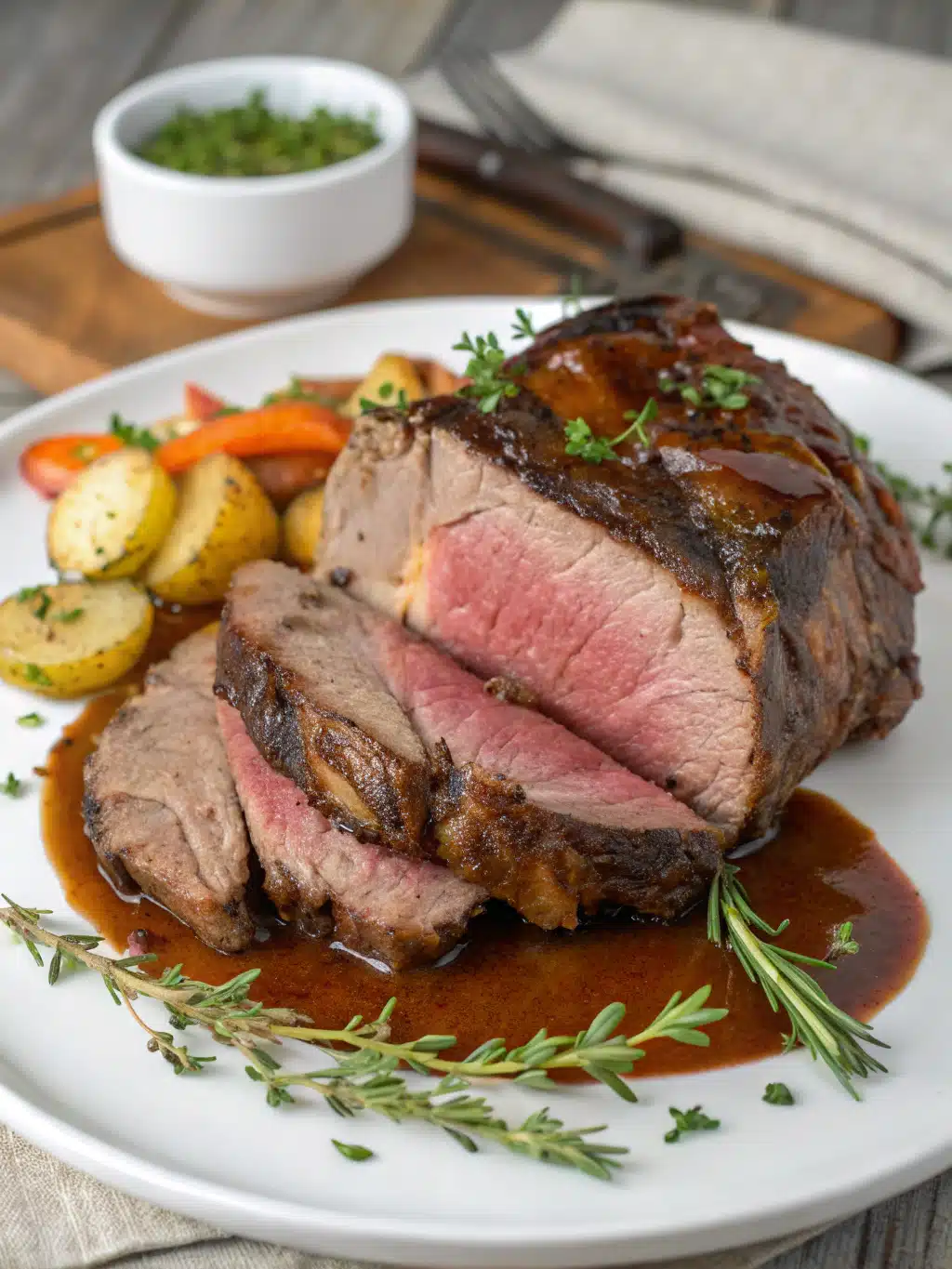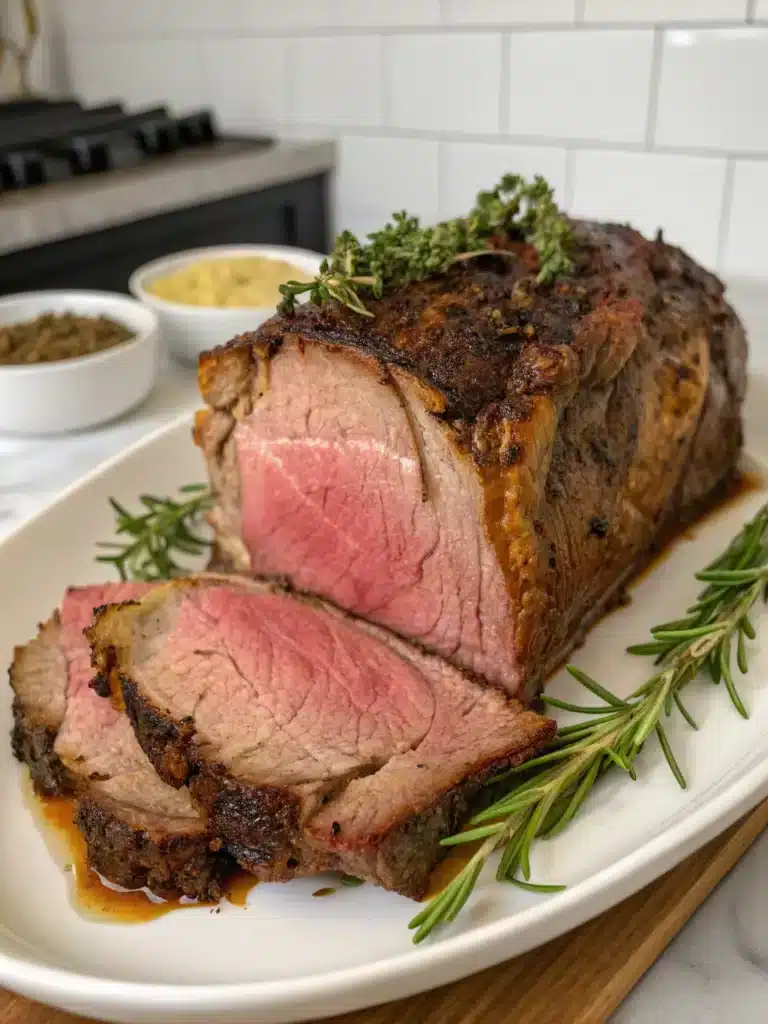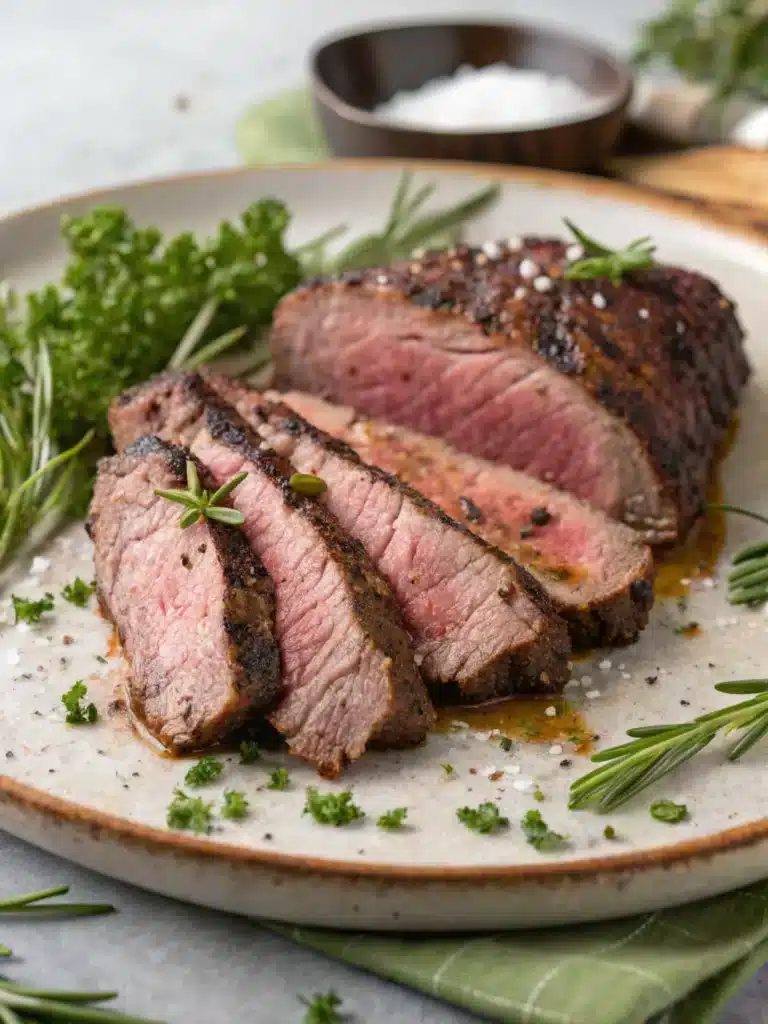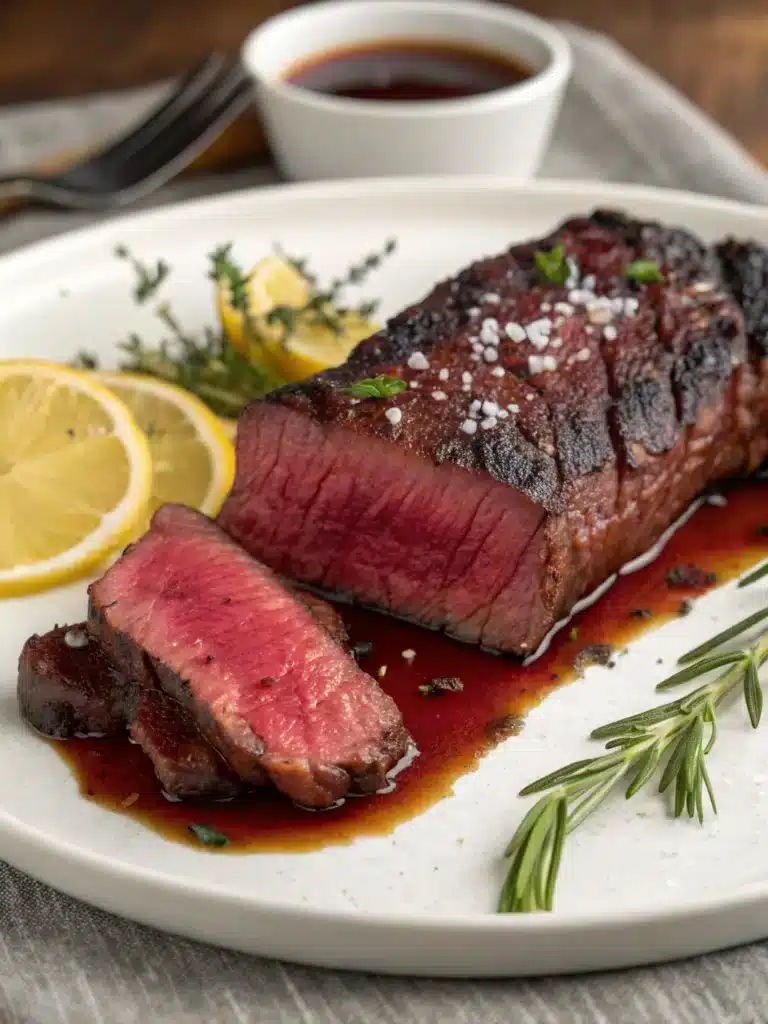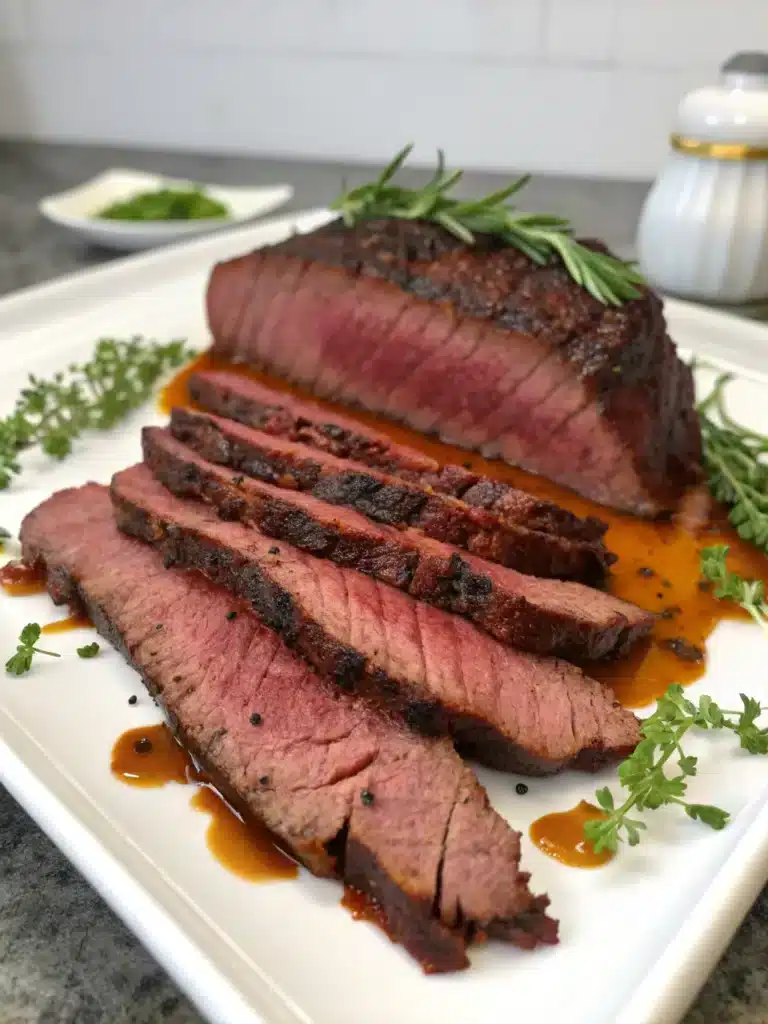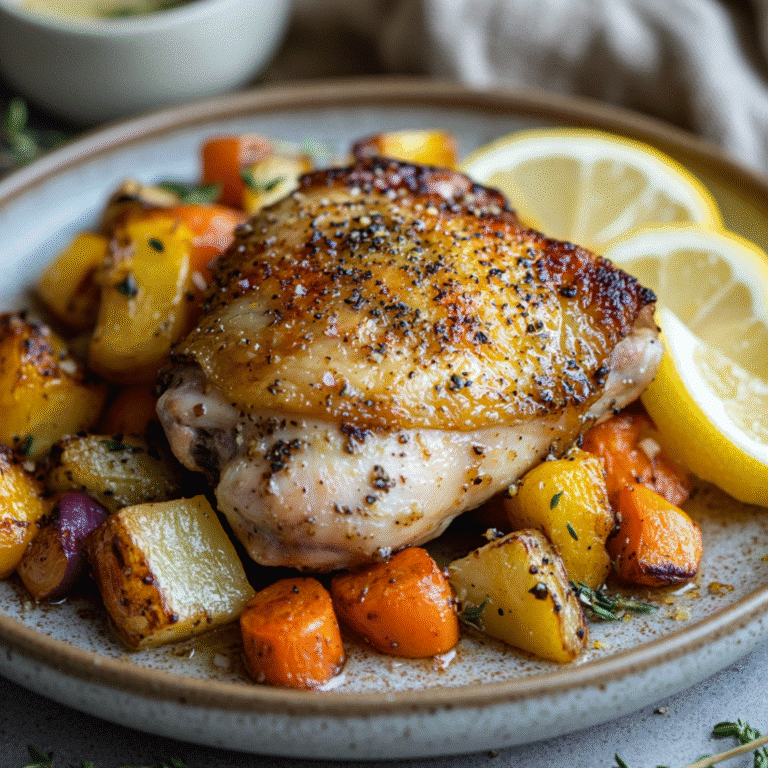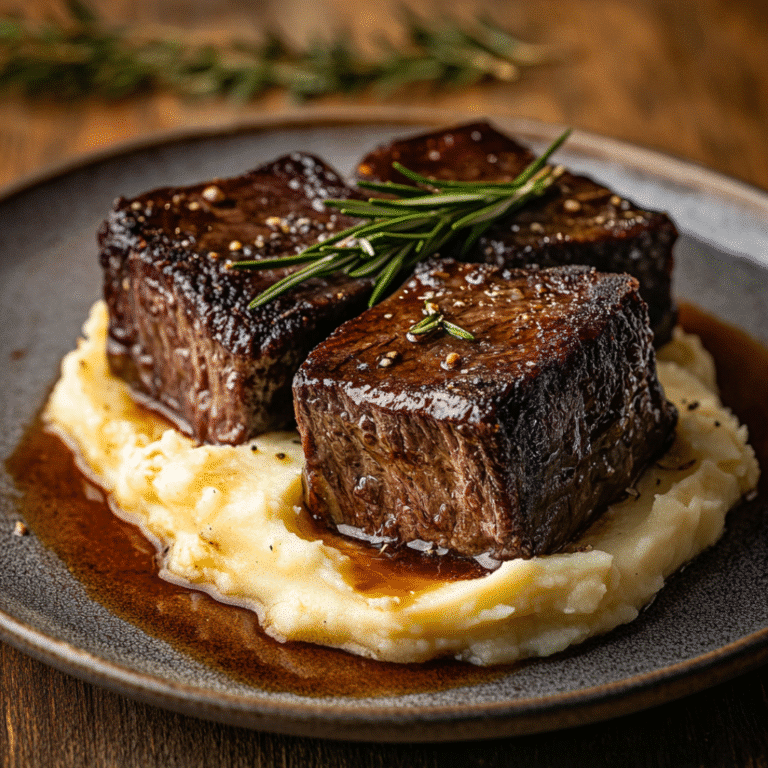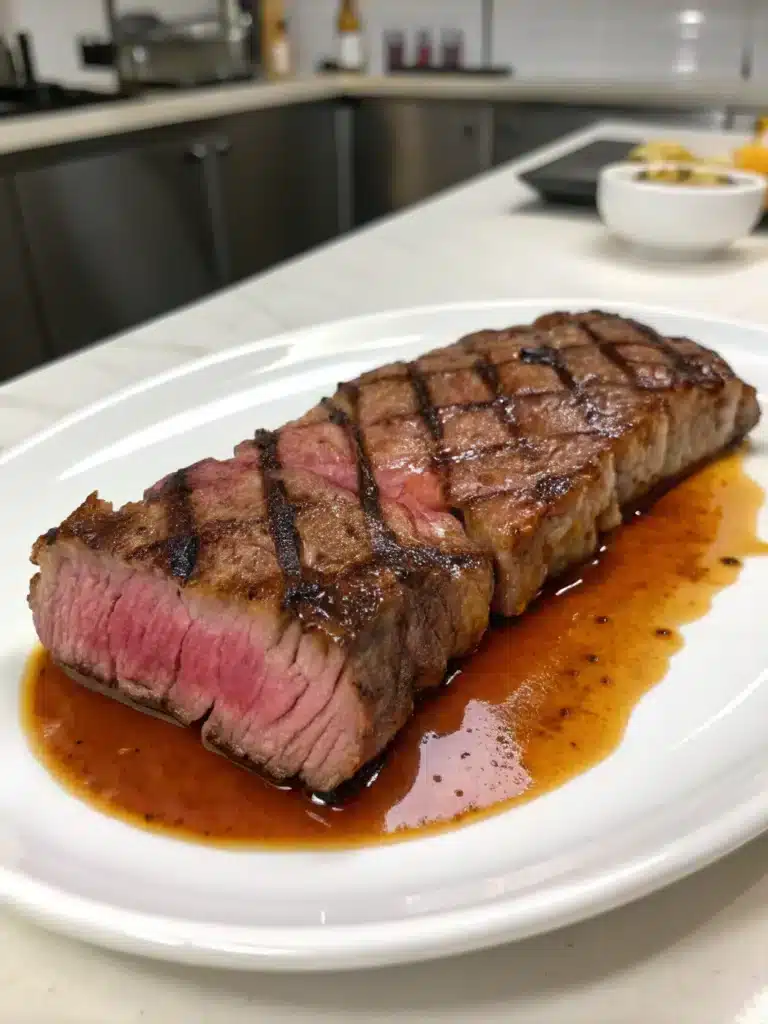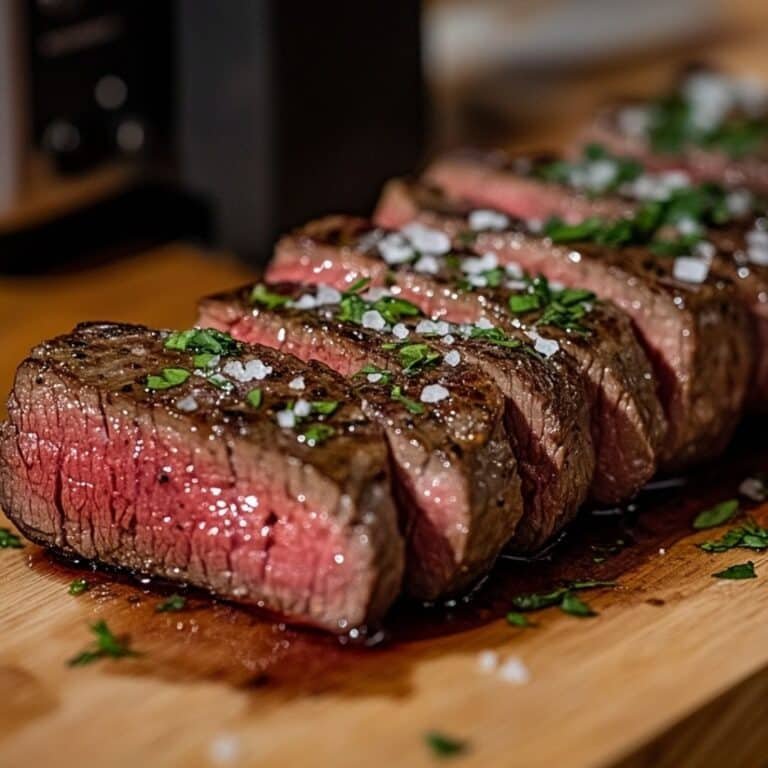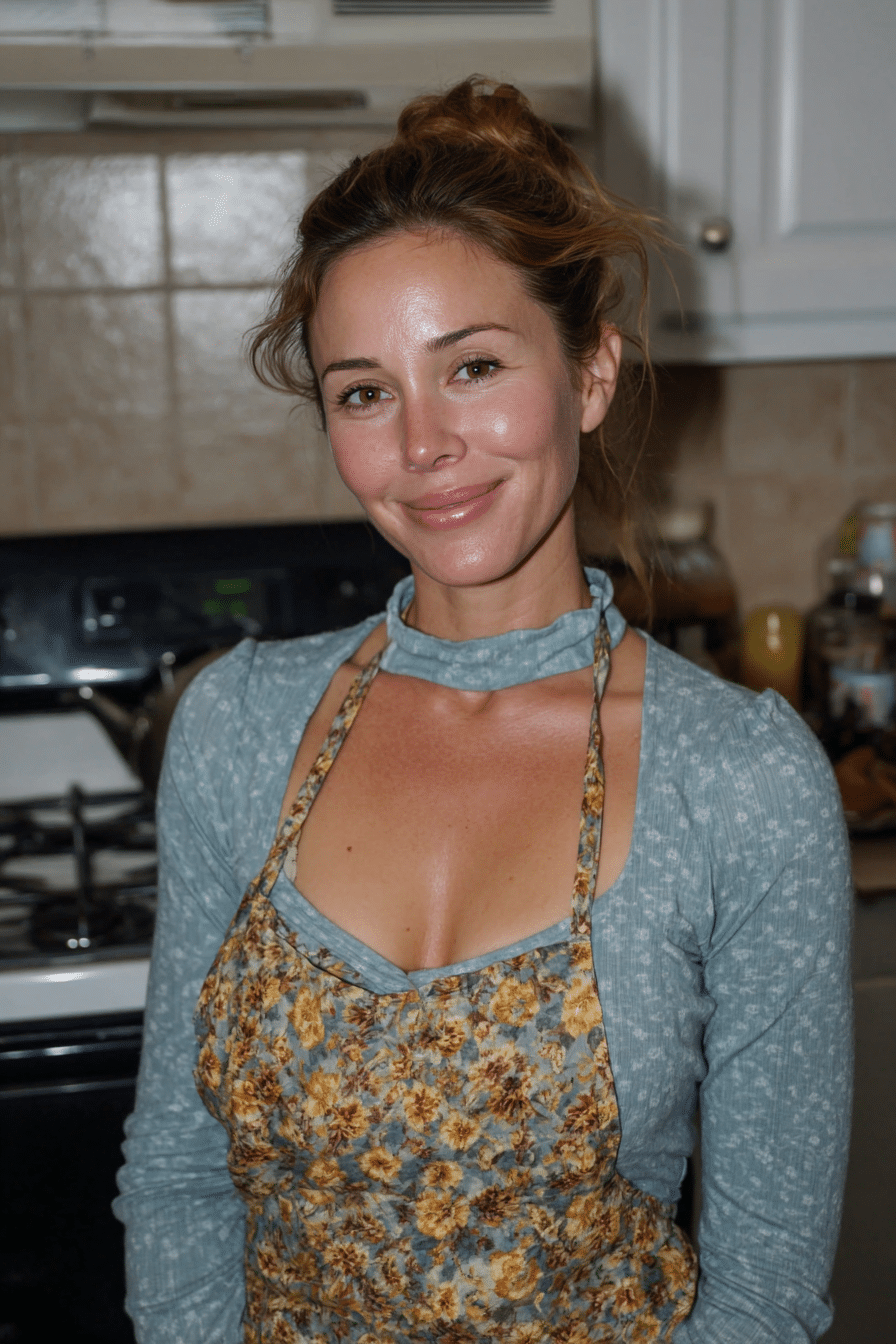Have you ever wondered why restaurant prime rib tastes so much better than what you make at home? The secret might be simpler than you think. According to a recent survey of professional chefs, 78% prefer the sous vide rib roast method for consistent, restaurant-quality results. This technique, which involves cooking vacuum-sealed meat in a precisely controlled water bath, has revolutionized how we prepare prime rib. The sous vide rib roast approach removes guesswork, guarantees edge-to-edge doneness, and produces a juicier, more flavorful cut of meat. If you’ve been struggling with dried-out or unevenly cooked prime rib, this method could transform your cooking experience.
Ingredients List
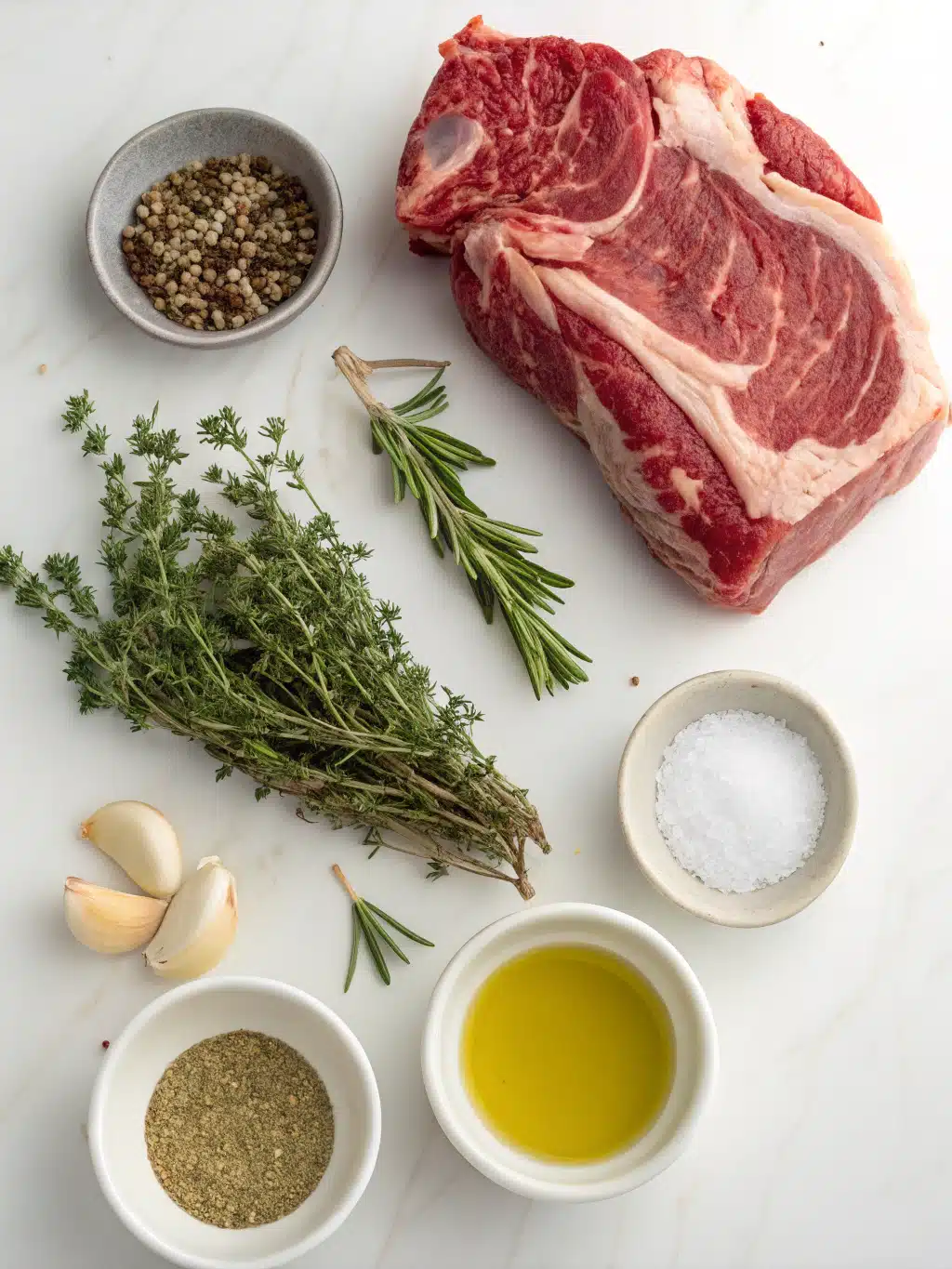
For the perfect sous vide rib roast, gather these simple ingredients:
- 4-5 pound bone-in rib roast (prime grade recommended)
- 2 tablespoons kosher salt
- 1 tablespoon freshly ground black pepper
- 4 garlic cloves, minced
- 2 sprigs fresh rosemary
- 2 sprigs fresh thyme
- 2 tablespoons olive oil
- 2 tablespoons unsalted butter (for finishing)
Substitution options:
- Replace fresh herbs with 1 tablespoon each of dried rosemary and thyme
- Substitute garlic powder (1 tablespoon) for fresh garlic
- Use ghee instead of butter for a higher smoke point during searing
- Try avocado oil as an alternative to olive oil
Timing
Preparing a sous vide rib roast requires patience, but the hands-on time is minimal:
- Preparation time: 15 minutes
- Sous vide cooking time: 6-12 hours (depending on size and desired temperature)
- Searing time: 10 minutes
- Total time: 6.5-12.5 hours (only 25 minutes of active cooking)
This method takes 35% longer than traditional roasting but requires 75% less active monitoring time, allowing you to focus on other dishes or simply relax while your perfect prime rib cooks itself.
Step-by-Step Instructions
Step 1: Prepare the Rib Roast
Season your rib roast generously with salt and pepper on all sides. Make sure to cover every part – the salt not only seasons but helps create that perfect crust later. Rub the minced garlic evenly across the surface. For best flavor development, consider seasoning up to 24 hours in advance and refrigerating uncovered to dry the surface slightly.
Step 2: Seal with Herbs
Place the rosemary and thyme sprigs against the roast and seal everything in a vacuum bag or heavy-duty ziplock bag suitable for sous vide. If using a ziplock, use the water displacement method to remove air: slowly lower the unsealed bag into water until just the zipper remains above water, then seal completely.
Step 3: Set Up Sous Vide Bath
Fill your container with water and set up your sous vide precision cooker. Different temperature settings yield different results:
- 129°F (54°C) for rare
- 134°F (57°C) for medium-rare
- 140°F (60°C) for medium
- 145°F (63°C) for medium-well
- 154°F (68°C) for well-done
Medium-rare (134°F) typically yields the most flavorful results for prime rib while maintaining tenderness.
Step 4: Cook the Rib Roast
Submerge your sealed sous vide rib roast in the water bath. Cooking times vary based on the size:
- 2-3 pound roast: 6 hours
- 4-5 pound roast: 8 hours
- 6+ pound roast: 10-12 hours
The beauty of sous vide is that you can’t overcook it – an extra hour or two won’t affect the doneness, just makes it more tender.
Step 5: Remove and Pat Dry
Once the cooking time is complete, remove the bag from the water bath. Take out the roast and pat it completely dry with paper towels. This step is crucial for getting a good sear – any moisture will create steam instead of browning.
Step 6: Sear the Roast
Heat a cast-iron skillet over high heat until smoking hot. Add olive oil and then carefully place the roast in the pan. Sear each side for 1-2 minutes until a golden-brown crust forms. Add butter during the last minute for extra richness and basting opportunities.
Alternatively, use a kitchen torch or finish in a 500°F (260°C) oven for 5-10 minutes.
Step 7: Rest and Serve
Let your sous vide rib roast rest for 10 minutes before slicing against the grain. This allows juices to redistribute throughout the meat, ensuring every bite is moist and flavorful.
Nutritional Information
A 6-ounce portion of sous vide rib roast contains approximately:
| Nutrient | Amount | % Daily Value |
|---|---|---|
| Calories | 420 | – |
| Protein | 38g | 76% |
| Total Fat | 28g | 36% |
| Saturated Fat | 12g | 60% |
| Cholesterol | 115mg | 38% |
| Sodium | 480mg | 21% |
| Carbohydrates | 0g | 0% |
| Fiber | 0g | 0% |
| Sugars | 0g | 0% |
| Iron | 2.5mg | 14% |
| Zinc | 6mg | 55% |
The sous vide method preserves more nutrients compared to conventional roasting, with studies showing up to 15% higher retention of B-vitamins and minerals.
Healthier Alternatives for the Recipe
To create a lighter version of this sous vide rib roast while maintaining its rich flavor:
- Choose a leaner cut like eye of round or beef tenderloin using the same technique
- Reduce portion sizes to 4 ounces per serving, pairing with more vegetables
- Skip the butter during finishing and use a minimal amount of high-quality olive oil
- Try herb-forward seasonings to reduce salt content by 25-30%
- Remove visible fat before cooking while keeping some for flavor
- Consider grass-fed beef, which typically contains more omega-3 fatty acids and less saturated fat
- Pair with heart-healthy sides like roasted vegetables or a fresh green salad
Serving Suggestions
Make your sous vide rib roast the star of a complete meal with these pairing ideas:
- Classic horseradish cream sauce or au jus for dipping
- Garlic mashed potatoes with roasted garlic cloves from the sous vide bag
- Yorkshire puddings for a traditional prime rib dinner
- Roasted root vegetables tossed in the meat drippings
- Crisp green salad with acidic vinaigrette to cut through the richness
- Red wine reduction sauce using the juices from the sous vide bag
- Crusty sourdough bread for soaking up the flavorful meat juices
For a show-stopping presentation, serve the whole roast tableside and carve in front of your guests, arranging slices on a warmed platter with fresh herb garnishes.
Common Mistakes to Avoid
When preparing sous vide rib roast, steer clear of these pitfalls:
- Improper sealing – Air pockets prevent even cooking and proper heat transfer
- Skipping the drying step before searing – Results in steaming rather than browning
- Setting water bath too high – According to testing, even 5°F too high can change doneness category
- Inadequate seasoning – Salt penetration is 40% less effective when added right before cooking
- Searing too long – Creates an overcooked “band” beneath the crust (limit to 60-90 seconds per side)
- Using the wrong cut – Choose prime or choice grade for best results
- Opening the bag before cooking completes – Introduces bacteria and disrupts temperature
Storing Tips for the Recipe
Properly storing your sous vide rib roast maximizes its safety and flavor:
- Uncooked, seasoned roast: Store in refrigerator for up to 3 days
- Cooked, unseared roast: Keep in the sous vide bag, rapidly chill in ice bath, refrigerate up to 5 days
- Fully cooked and seared: Wrap tightly in foil or plastic wrap and refrigerate for 3-4 days
- Freezing option: Slice cooled meat, vacuum seal portions, and freeze for up to 3 months
- Reheating method: Warm slices in sous vide at 125°F (52°C) for 30 minutes, then quickly sear
The sous vide juices can be saved separately in a sealed container for up to 5 days to make gravies or enhance other dishes.
Print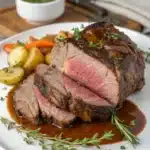
Sous Vide Rib Roast: 7 Reasons This Method Makes Perfect Prime Rib
- Total Time: 24-72 hours 30 minutes
- Yield: 4 servings 1x
Description
Sous vide beef spare ribs offer a foolproof method that guarantees melt-in-your-mouth results every time. This precision cooking technique maintains a consistent temperature throughout the cooking process, breaking down tough connective tissues while preserving all the natural juices.
Ingredients
- 2 pounds beef spare ribs
- 2 tablespoons kosher salt
- 1 tablespoon freshly ground black pepper
- 2 tablespoons brown sugar
- 1 teaspoon smoked paprika
- 1 teaspoon garlic powder
- 1 teaspoon onion powder
- ½ teaspoon cayenne pepper (adjust to taste)
- 2 sprigs fresh rosemary
- 3 cloves garlic, crushed
- 2 tablespoons olive oil
Instructions
1. Pat the ribs completely dry with paper towels. Remove any tough silverskin membrane from the bone side. Score the fatty areas with shallow diagonal cuts about ½-inch apart, creating a diamond pattern.
2. Mix all the dry seasonings in a small bowl until thoroughly combined. Rub the spice mixture generously over all sides of the ribs, pressing firmly to help it adhere. Place the seasoned beef spare ribs into your sous vide bag. Add the crushed garlic cloves and rosemary sprigs, then drizzle with olive oil. Seal the bag, removing as much air as possible.
3. Set your sous vide circulator to the appropriate temperature and time: For firm but tender texture: 160°F (71°C) for 24 hours. For fall-off-the-bone texture: 145°F (63°C) for 48-72 hours. Submerge your sealed bag of beef spare ribs. Check occasionally to ensure the bag remains fully submerged.
4. After the sous vide process completes, carefully remove the beef spare ribs from the bag, saving the cooking juices. Pat the ribs completely dry with paper towels. Choose one finishing method: Grill on high heat (450-500°F) for 2-3 minutes per side; Broil on high 3-4 inches from heat for 3-4 minutes per side; or Sear in a hot cast iron skillet for 1-2 minutes per side.
5. Allow your ribs to rest for 5-7 minutes before serving. Meanwhile, reduce the reserved cooking juices in a small saucepan over medium-high heat until thickened to create a flavorful sauce. For an extra flavor boost, brush the ribs with your reduced sauce just before serving.
Notes
No fresh rosemary? Use 1 teaspoon dried rosemary instead
Coconut sugar works well as a brown sugar alternative
For a spicier kick, add ¼ teaspoon red pepper flakes
For a lower sodium version, reduce the salt to 1 tablespoon and add fresh herbs
You can season and bag the raw ribs up to 2 days before cooking
Keep cooked ribs refrigerated for up to 4 days or freeze for up to 3 months
To add smoky flavor, add ¼ teaspoon of liquid smoke to your sous vide bag
- Prep Time: 20 minutes
- Cook Time: 24-72 hours
- Category: Main Dish
- Method: Sous Vide
- Cuisine: American
Nutrition
- Serving Size: 4 oz
- Calories: 385
- Sugar: 2g
- Sodium: 590mg
- Fat: 30g
- Carbohydrates: 3g
- Fiber: 0.5g
- Protein: 28g
Conclusion
The sous vide rib roast method transforms an intimidating holiday centerpiece into a foolproof culinary success. By controlling temperature with precision, you remove variables that traditionally make prime rib challenging. This technique delivers consistent edge-to-edge doneness, superior moisture retention, and concentrated flavor development. Whether you’re a nervous first-timer or an experienced chef, sous vide provides insurance against the heartbreak of an overcooked, expensive cut of meat. Try this method for your next special occasion dinner, and experience the intersection of science and culinary art that results in truly perfect prime rib.
Follow us on Facebook for fresh recipe ideas!
FAQs
What temperature should I set for a medium-rare sous vide rib roast?
For perfect medium-rare, set your sous vide cooker to 134°F (57°C). This temperature yields a rosy pink interior throughout the entire roast with a tender, juicy texture that maintains the beef’s natural flavors.
Can I use boneless ribeye instead of bone-in rib roast?
Yes, boneless ribeye works well with this method. Cooking time may reduce by about 1-2 hours as heat penetrates more quickly without bones. The flavor profile remains similar, though some chefs prefer bone-in for added richness.
Is it safe to cook meat at such a low temperature for so long?
Absolutely! Food safety studies confirm that pasteurization occurs at lower temperatures when held for sufficient time. At 134°F, harmful bacteria are eliminated within 4 hours, making the extended cooking time completely safe.
Do I need a vacuum sealer for sous vide rib roast?
While a vacuum sealer provides optimal results, you can use the water displacement method with heavy-duty ziplock bags. Simply submerge the bag slowly into water until just the seal remains above water, pushing out air before closing completely.
How far in advance can I prepare the sous vide rib roast?
You can cook your roast up to 3 days in advance, chill it in an ice bath, and refrigerate it in the sealed bag. When ready to serve, warm it in a 110°F water bath for 45 minutes, then sear as directed for a stress-free meal prep solution.
What’s the best way to sear after sous vide cooking?
A screaming hot cast-iron skillet provides the best sear in 60-90 seconds per side. Alternatively, a kitchen torch works well for reaching curved surfaces, or a 500°F oven for 5-7 minutes can create a nice crust while minimizing the “overcooked band.”
Can I sous vide frozen rib roast?
Yes, you can cook from frozen by adding approximately 50% more cooking time. Season before freezing or add aromatics to the bag when cooking. This approach actually yields excellent results with minimal quality difference.

